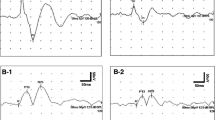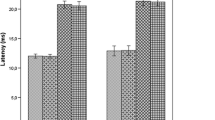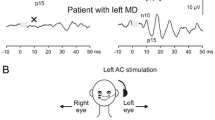Abstract
Vestibular-evoked myogenic potentials (VEMPs) are short latency manifestations of vestibulo-ocular and vestibulocollic reflexes that originate from the utricle and saccule. Although cervical and ocular VEMPs have mostly been applied to peripheral vestibular disorders, the characteristics and the diagnostic values of VEMPs have been expanded to assess the function of the central otolithic pathways. In the central nervous system, the cervical VEMPs (cVEMPs) are mediated by the vestibular nuclei and uncrossed medial vestibulospinal tract descending in the lower brainstem and spinal cord. In contrast, the ocular VEMPs (oVEMPs) reflect the function of the vestibular nuclei and the crossed vestibulo-ocular reflex (VOR) pathways, mostly contained in the medial longitudinal fasciculus (MLF). Therefore, lesions involving the vestibular nuclei can present abnormalities of both cVEMPs and oVEMPs. The medullary lesions involving the descending MLF or the spinal accessory nucleus impair cVEMPs. In contrast, the lesions involving the MLF, the crossed ventral tegmental tract, oculomotor nuclei and the interstitial nucleus of Cajal can impair oVEMPs. Patients with unilateral cerebellar infarctions may show abnormal VEMPs especially when they have the ocular tilt reaction. Delayed responses of VEMPs are characteristic of multiple sclerosis (MS). Reduced VEMP responses can be observed in patients with vestibular migraine. VEMPs are useful in evaluating central as well as peripheral otolithic function that are not readily defined by conventional vestibular function tests, and can aid in detecting and localizing central lesions, especially silent brainstem lesions such as tiny infarctions or MS plaques.


Similar content being viewed by others
References
Colebatch JG, Halmagyi GM (1992) Vestibular evoked potentials in human neck muscles before and after unilateral vestibular deafferentation. Neurology 42(8):1635–1636
Colebatch JG, Halmagyi GM, Skuse NF (1994) Myogenic potentials generated by a click-evoked vestibulocollic reflex. J Neurol Neurosurg Psychiatry 57(2):190–197
Curthoys IS (2010) A critical review of the neurophysiological evidence underlying clinical vestibular testing using sound, vibration and galvanic stimuli. Clin Neurophysiol 121(2):132–144
Todd NP et al (2007) Ocular vestibular evoked myogenic potentials (OVEMPs) produced by air- and bone-conducted sound. Clin Neurophysiol 118(2):381–390
Oh SY et al (2013) Ocular vestibular evoked myogenic potentials induced by air-conducted sound in patients with acute brainstem lesions. Clin Neurophysiol 124(4):770–778
Oh SY et al (2013) Cervical and ocular vestibular-evoked myogenic potentials in vestibular neuritis: comparison between air- and bone-conducted stimulation. J Neurol 260(8):2102–2109
Iwasaki S et al (2007) Head taps evoke a crossed vestibulo-ocular reflex. Neurology 68(15):1227–1229
Buttner-Ennever JA (1992) Patterns of connectivity in the vestibular nuclei. Ann NY Acad Sci 656:363–378
Rosengren SM et al (2007) Delayed vestibular evoked responses to the eyes and neck in a patient with an isolated brainstem lesion. Clin Neurophysiol 118(9):2112–2116
Kim HJ et al (2014) Isolated vestibular nuclear infarction: report of two cases and review of the literature. J Neurol 261(1):121–129
Heide G et al (2010) Brainstem representation of vestibular evoked myogenic potentials. Clin Neurophysiol 121(7):1102–1108
Newlands SD et al (2003) Central projections of the saccular and utricular nerves in macaques. J Comp Neurol 466(1):31–47
Nyberg-Hansen R (1964) Origin and termination of fibers from the vestibular nuclei descending in the medial longitudinal fasciculus. An experimental study with silver impregnation methods in the cat. J Comp Neurol 122:355–367
Uchino Y et al (1994) Monosynaptic and disynaptic connections in the utriculo-ocular reflex arc of the cat. J Neurophysiol 71(3):950–958
Uchino Y et al (1996) Utriculoocular reflex arc of the cat. J Neurophysiol 76(3):1896–1903
Uchino Y, Kushiro K (2011) Differences between otolith- and semicircular canal-activated neural circuitry in the vestibular system. Neurosci Res 71(4):315–327
Kushiro K et al (1999) Saccular and utricular inputs to sternocleidomastoid motoneurons of decerebrate cats. Exp Brain Res 126(3):410–416
Isu N et al (2000) Sacculo-ocular reflex connectivity in cats. Exp Brain Res 131(3):262–268
Goto F et al (2004) Eye movements evoked by selective saccular nerve stimulation in cats. Auris Nasus Larynx 31(3):220–225
Uchino Y et al (1997) Sacculocollic reflex arcs in cats. J Neurophysiol 77(6):3003–3012
Kim HJ, Lee JH, Kim JS (2014) Ocular vestibular evoked myogenic potentials to head tap and cervical vestibular evoked myogenic potentials to air-conducted sounds in isolated internuclear ophthalmoplegia. Clin Neurophysiol 125(5):1042–1047
Itoh A et al (2001) Clinical study of vestibular-evoked myogenic potentials and auditory brainstem responses in patients with brainstem lesions. Acta Otolaryngol Suppl 545:116–119
Kim S, Kim HJ, Kim JS (2011) Impaired sacculocollic reflex in lateral medullary infarction. Front Neurol 2:8
Tseng CL, Young YH (2010) Topographical correlations of lateral medullary infarction with caloric- and vestibular-evoked myogenic potential results. Eur Arch Otorhinolaryngol 267(2):191–195
Kim S, Lee HS, Kim JS (2010) Medial vestibulospinal tract lesions impair sacculo-collic reflexes. J Neurol 257(5):825–832
Rosengren SM, Colebatch JG (2011) Ocular vestibular evoked myogenic potentials are abnormal in internuclear ophthalmoplegia. Clin Neurophysiol 122(6):1264–1267
Highstein SM, Holstein GR (2006) The anatomy of the vestibular nuclei. Prog Brain Res 151:157–203
Newlands SD et al (2002) Central projections of the utricular nerve in the gerbil. J Comp Neurol 452(1):11–23
Ito M (1982) Cerebellar control of the vestibulo-ocular reflex–around the flocculus hypothesis. Annu Rev Neurosci 5:275–296
Angelaki DE, Hess BJ (1995) Lesion of the nodulus and ventral uvula abolish steady-state off-vertical axis otolith response. J Neurophysiol 73(4):1716–1720
Welgampola MS, Colebatch JG (2005) Characteristics and clinical applications of vestibular-evoked myogenic potentials. Neurology 64(10):1682–1688
Pollak L, Kushnir M, Stryjer R (2006) Diagnostic value of vestibular evoked myogenic potentials in cerebellar and lower-brainstem strokes. Neurophysiol Clin 36(4):227–233
Ahn BH et al (2011) Abnormal cervical vestibular-evoked myogenic potential in anterior inferior cerebellar artery territory infarction: frequency, pattern, and a determinant. J Neurol Sci 307(1–2):114–119
Choi SY et al (2014) Impaired modulation of the otolithic function in acute unilateral cerebellar infarction. Cerebellum 13(3):362–371
Kirchner H et al (2011) Clinical, electrophysiological, and MRI findings in patients with cerebellar ataxia and a bilaterally pathological head-impulse test. Ann NY Acad Sci 1233:127–138
Takegoshi H, Murofushi T (2000) Vestibular evoked myogenic potentials in patients with spinocerebellar degeneration. Acta Otolaryngol 120(7):821–824
Marti S et al (2008) Dissociation between canal- and otolithfunction in cerebellar atrophy. J Neurol 255(5):769–771
Rabinovitch HE, Sharpe JA, Sylvester TO (1977) The ocular tilt reaction. A paroxysmal dyskinesia associated with elliptical nystagmus. Arch Ophthalmol 95(8):1395–1398
Su CH, Young YH (2011) Differentiating cerebellar and brainstem lesions with ocular vestibular-evoked myogenic potential test. Eur Arch Otorhinolaryngol 268(6):923–930
Williams NP, Roland PS, Yellin W (1997) Vestibular evaluation in patients with early multiple sclerosis. Am J Otol 18(1):93–100
Shimizu K et al (2000) Vestibular evoked myogenic potentials in multiple sclerosis. J Neurol Neurosurg Psychiatry 69(2):276–277
Alpini D et al (2004) Vestibular evoked myogenic potentials in multiple sclerosis: clinical and imaging correlations. Mult Scler 10(3):316–321
Versino M et al (2002) Vestibular evoked myogenic potentials in multiple sclerosis patients. Clin Neurophysiol 113(9):1464–1469
Bandini F et al (2004) The diagnostic value of vestibular evoked myogenic potentials in multiple sclerosis. J Neurol 251(5):617–621
Eleftheriadou A et al (2009) The diagnostic value of earlier and later components of vestibular evoked myogenic potentials (VEMP) in multiple sclerosis. J Vestib Res 19(1–2):59–66
Colebatch JG (2012) Vestibular evoked myogenic potentials in multiple sclerosis. Clin Neurophysiol 123(9):1693–1694
Gabelic T et al (2013) Ocular and cervical vestibular evoked myogenic potentials in patients with multiple sclerosis. J Clin Neurophysiol 30(1):86–91
Gazioglu S, Boz C (2012) Ocular and cervical vestibular evoked myogenic potentials in multiple sclerosis patients. Clin Neurophysiol 123(9):1872–1879
Murofushi T et al (2001) Diagnostic value of prolonged latencies in the vestibular evoked myogenic potential. Arch Otolaryngol Head Neck Surg 127(9):1069–1072
von Brevern M et al (2005) Acute migrainous vertigo: clinical and oculographic findings. Brain 128(Pt 2):365–374
Baier B, Stieber N, Dieterich M (2009) Vestibular-evoked myogenic potentials in vestibular migraine. J Neurol 256(9):1447–1454
Baier B, Dieterich M (2009) Vestibular-evoked myogenic potentials in “vestibular migraine” and Meniere’s disease: a sign of an electrophysiological link? Ann NY Acad Sci 1164:324–327
Boldingh MI et al (2011) Vestibular sensitivity in vestibular migraine: VEMPs and motion sickness susceptibility. Cephalalgia 31(11):1211–1219
Zuniga MG et al (2012) Can vestibular-evoked myogenic potentials help differentiate Meniere disease from vestibular migraine? Otolaryngol Head Neck Surg 146(5):788–796
Taylor RL et al (2012) Vestibular evoked myogenic potentials to sound and vibration: characteristics in vestibular migraine that enable separation from Meniere’s disease. Cephalalgia 32(3):213–225
Stephan T et al (2005) Functional MRI of galvanic vestibular stimulation with alternating currents at different frequencies. Neuroimage 26(3):721–732
Fasold O et al (2002) Human vestibular cortex as identified with caloric stimulation in functional magnetic resonance imaging. Neuroimage 17(3):1384–1393
Schlindwein P et al (2008) Cortical representation of saccular vestibular stimulation: VEMPs in fMRI. Neuroimage 39(1):19–31
Bremmer F et al (2001) Polymodal motion processing in posterior parietal and premotor cortex: a human fMRI study strongly implies equivalencies between humans and monkeys. Neuron 29(1):287–296
Bense S et al (2001) Multisensory cortical signal increases and decreases during vestibular galvanic stimulation (fMRI). J Neurophysiol 85(2):886–899
Cheng PW et al (2009) Acoustic, mechanical and galvanic stimulation modes elicit ocular vestibular-evoked myogenic potentials. Clin Neurophysiol 120(10):1841–1844
Papathanasiou ES et al (2014) International guidelines for the clinical application of cervical vestibular evoked myogenic potentials: an expert consensus report. Clin Neurophysiol 125(4):658–666
Acknowledgments
This work was supported by research funds of Chonbuk National University in 2015 and by Research Institute of Clinical Medicine of Chonbuk National University-Chonbuk National University Hospital.
Author information
Authors and Affiliations
Corresponding author
Ethics declarations
Conflicts of interest
Oh is supported by research funds of Chonbuk National University in 2014 and by Research Institute of Clinical Medicine of Chonbuk National University- Chonbuk National University Hospital. HJ Kim reports no disclosures. JS Kim serves as an Associate Editor of Frontiers in Neuro-otology and on the editorial boards of the Journal of Clinical Neurology, Frontiers in Neuro-ophthalmology, Journal of Neuro-ophthalmology, Journal of Vestibular Research, and Journal of Neurology.
Rights and permissions
About this article
Cite this article
Oh, SY., Kim, HJ. & Kim, JS. Vestibular-evoked myogenic potentials in central vestibular disorders. J Neurol 263, 210–220 (2016). https://doi.org/10.1007/s00415-015-7860-y
Received:
Revised:
Accepted:
Published:
Issue Date:
DOI: https://doi.org/10.1007/s00415-015-7860-y




